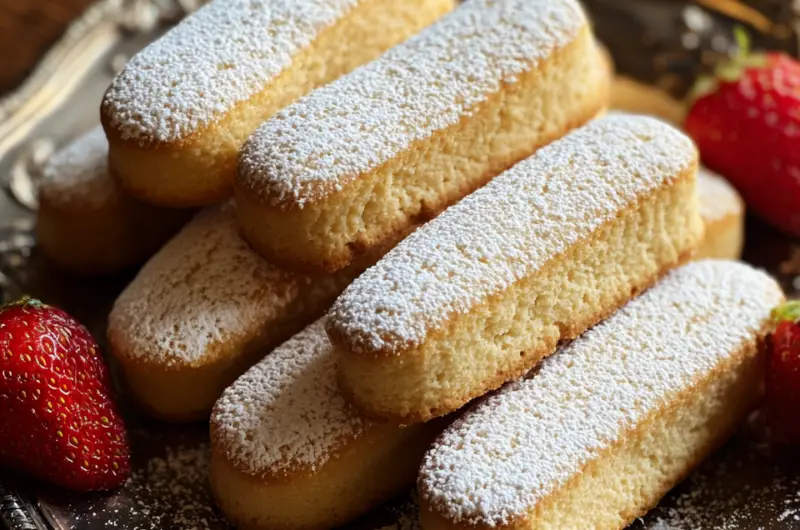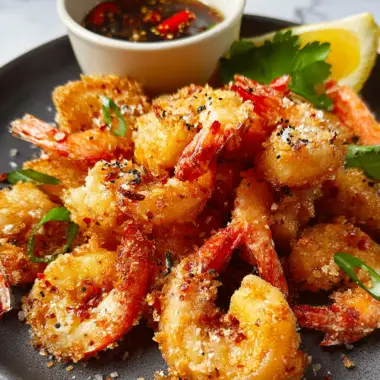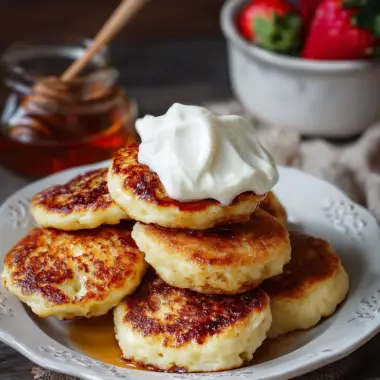Ladyfingers, also known as Savoiardi, are a staple of Italian pastry culture and an essential ingredient in classic desserts like tiramisu. These airy, delicate sponge cookies are made with simple ingredients eggs, sugar, and flour whipped into a light batter and piped into elegant finger-shaped forms. Baked to perfection, they achieve a unique texture that is both crisp on the outside and softly cakey on the inside. Their subtle sweetness and spongy consistency make them ideal for soaking up espresso, liqueur, or creamy layers in desserts. These cookies are not only versatile but also fun and satisfying to make at home. They bring an artisan touch to your baking repertoire and elevate any dessert they are used in. While their most famous role is in a traditional tiramisu, ladyfingers can also be enjoyed with a dusting of powdered sugar and a hot cup of tea. Whether you’re aiming to impress guests or simply savor a homemade treat, these Italian cookies offer timeless elegance and delightful flavor.
Full Recipe:
Ingredients:
-
4 large eggs, separated
-
⅔ cup granulated sugar, divided
-
1 tsp vanilla extract
-
¾ cup all-purpose flour
-
2 tbsp cornstarch
-
¼ tsp salt
-
Powdered sugar, for dusting
Directions:
-
Preheat oven to 350°F (175°C). Line two baking sheets with parchment paper.
-
In a large bowl, beat the egg yolks with half of the sugar and vanilla extract until thick and pale.
-
In a separate bowl, beat egg whites until soft peaks form. Gradually add remaining sugar and continue beating until stiff peaks form.
-
Gently fold the egg whites into the yolk mixture.
-
Sift together the flour, cornstarch, and salt. Gradually fold into the egg mixture, being careful not to deflate the batter.
-
Transfer the batter into a piping bag fitted with a round tip. Pipe 4-inch long strips onto the prepared baking sheets, leaving space between each.
-
Lightly dust the tops with powdered sugar.
-
Bake for 10-12 minutes or until lightly golden and firm to the touch.
-
Allow to cool on the baking sheet before transferring to a wire rack.
Prep Time: 15 minutes | Cooking Time: 12 minutes | Total Time: 27 minutes
Kcal: 55 kcal | Servings: 24 cookies
The Elegant Simplicity of Homemade Ladyfingers (Savoiardi)
Ladyfingers also known by their Italian name, Savoiardi are one of the most delicate and versatile cookies in European pastry. Light, airy, and with just the right amount of sweetness, these elongated sponge cakes play a starring role in several iconic desserts, most notably the world-famous tiramisu. But there is much more to ladyfingers than just being a dessert component; they carry centuries of culinary tradition and offer a delightful balance between cake and cookie.
In this article, we’ll explore the history, versatility, and cultural significance of ladyfingers, why homemade versions are superior to store-bought, how to use them in a variety of sweet creations, and some helpful baking insights that can elevate your own version of this classic treat.
A Bite-Sized History of Ladyfingers
Ladyfingers have roots that reach back to the 15th century, originating in the court of the Duchy of Savoy (which bordered modern-day France and Italy). They were initially created to honor a visit from the King of France and were called “Savoiardi” after the Savoy region. These elegant biscuits quickly became favored throughout European nobility, symbolizing refinement and luxury.
They eventually made their way across the continent, adopted and adapted by different cultures. The French referred to them as biscuits à la cuillère, while in the UK they became known simply as ladyfingers due to their slim, finger-like shape. Regardless of the name, their appeal remained the same light texture, subtle sweetness, and a tender sponge that soaks up liquids without falling apart.
Why Homemade Ladyfingers Are Worth the Effort
In most grocery stores today, you can find pre-packaged ladyfingers. While they offer convenience, they often fall short in taste and texture. Homemade ladyfingers have a softer crumb, a fresher flavor, and a more balanced sweetness. When made from scratch, they are lighter and more delicate, with a melt-in-your-mouth quality that packaged versions rarely replicate.
Additionally, making ladyfingers at home gives you control over the ingredients. You can avoid additives, preservatives, or artificial flavorings and stick with fresh eggs, quality vanilla, and unbleached flour. The freshness of homemade ladyfingers also enhances the final product when they’re used in layered desserts they soak liquids better and retain their shape with a lovely tenderness.
The Art and Science Behind the Texture
The unique texture of ladyfingers comes from a delicate process of whipping egg yolks and whites separately before folding them together. This aeration is what gives the cookies their characteristic lightness. Cornstarch is often added to stabilize the batter and give the finished product a fine, crumbly edge that contrasts beautifully with their soft center.
Dusting the unbaked cookies with powdered sugar is another important step it creates a slight crust that allows them to crisp up while still being soft enough to absorb coffee, liqueurs, or custards later on.
Ladyfingers are often baked freeform, piped into long finger shapes with a pastry bag. However, they can also be made into circles, ovals, or other decorative shapes depending on the intended dessert presentation.
Cultural and Culinary Versatility
Ladyfingers are one of those rare ingredients that can be both the star and a supporting character in desserts. In tiramisu, they are soaked in espresso and layered with mascarpone cream and cocoa. In English trifles, they’re layered with custard, fruit, and whipped cream. In charlottes, ladyfingers form the elegant outer shell of a molded dessert filled with mousse, cream, or Bavarian custard.
You can also serve them simply with whipped cream and fresh berries, dip them in chocolate for a crunchy-sweet snack, or enjoy them on their own with a cup of tea or coffee. Their neutral flavor and absorbent quality make them ideal for creativity in the kitchen.
Here are a few ideas to use your homemade ladyfingers:
-
Tiramisu – The most iconic use. A good tiramisu relies on quality ladyfingers.
-
Fruit Trifles – Layer ladyfingers with seasonal fruit and custard for an elegant dessert.
-
Icebox Cakes – Stack them with whipped cream or mousse and chill for a no-bake treat.
-
Charlotte Cake – Line a mold with ladyfingers and fill with mousse or Bavarian cream.
-
Affogato Topping – Use one or two as a crunchy topping over vanilla gelato and espresso.
-
Snack Cookies – Simply dusted with powdered sugar, they’re perfect for teatime.
Tips for Success When Baking Ladyfingers
Baking ladyfingers from scratch is not difficult, but it does require precision and a gentle touch. Here are some expert tips to help ensure success:
-
Separate Eggs Carefully: Egg whites must be free of any yolk to whip properly.
-
Whip to Soft and Stiff Peaks: Whip yolks until thick and pale; whites to stiff peaks for volume.
-
Fold Gently: When combining the yolk mixture with whipped whites, use a light hand to avoid deflating the batter.
-
Pipe Uniformly: Use a piping bag to ensure evenly sized cookies for even baking.
-
Use a Sifter: Dust powdered sugar through a fine sieve to avoid clumps and achieve an even coating.
-
Don’t Overbake: Watch closely; overbaking can make them dry and too brittle. Aim for light golden edges with a soft interior.
Perfect Pairings for Ladyfingers
Ladyfingers naturally complement a variety of beverages and desserts. Try serving them alongside:
-
Espresso or cappuccino – Their subtle sweetness balances bitter coffee.
-
Vin Santo or sherry – Their sponge texture soaks up dessert wine beautifully.
-
Mascarpone cream – A dollop of mascarpone and fresh fruit is a delightful light dessert.
-
Hot chocolate – Dip them into rich, creamy cocoa for a warm indulgence.
A Dessert That Transcends Generations
What makes ladyfingers particularly special is their timelessness. Generations of bakers have passed down recipes with slight variations, yet the result remains comfortingly familiar. They are humble, elegant, and nostalgic all at once. Whether you’re recreating your nonna’s tiramisu or trying your hand at a modern take on a charlotte, ladyfingers are the foundational canvas.
Advertisement
Moreover, the simplicity of ingredients eggs, sugar, flour makes them accessible to most home bakers. And though they seem refined, the method is something even beginner bakers can master with practice.
Conclusion:
Ladyfingers are more than just a vehicle for mascarpone or custard they’re a celebration of old-world technique, European pastry history, and the enduring appeal of light, simple baking. Homemade ladyfingers bring a freshness and authenticity that elevates any dessert. Whether enjoyed alone or as part of a layered creation, they carry a quiet elegance that makes them irresistible.
By making ladyfingers from scratch, you’re not just baking cookies you’re continuing a centuries-old tradition of craftsmanship, care, and culinary artistry. Perfectly sweet, delightfully spongy, and incredibly versatile, they belong in every baker’s repertoire.








